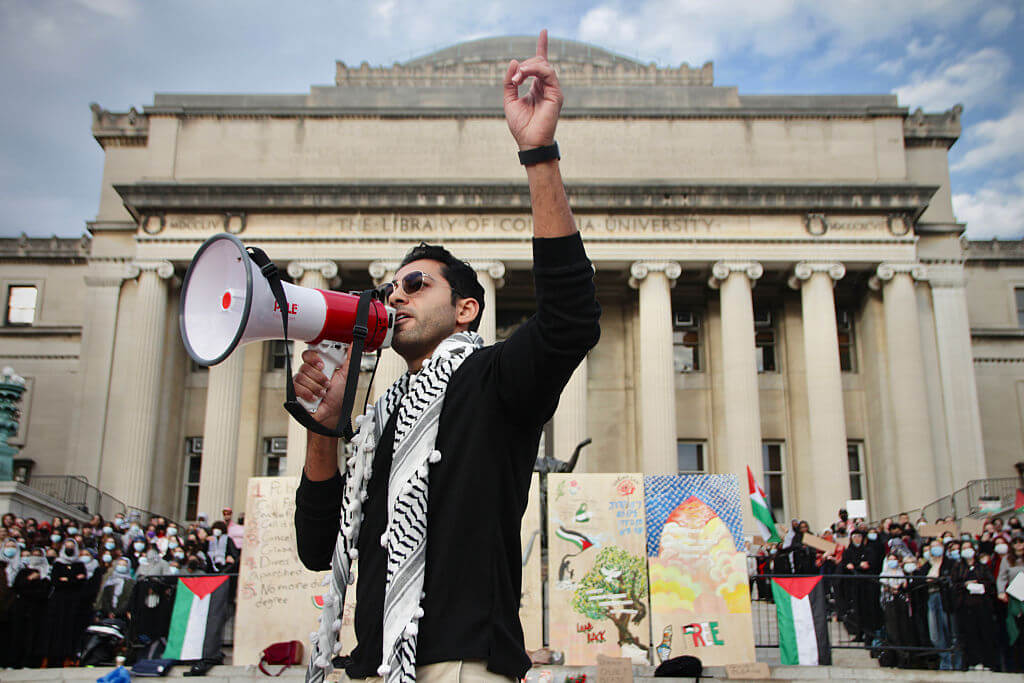Nazi collaborator monuments in India
While Subhas Chandra Bose is seen by some as a freedom fighter, his alliance with Hitler and the Waffen-SS cannot be ignored
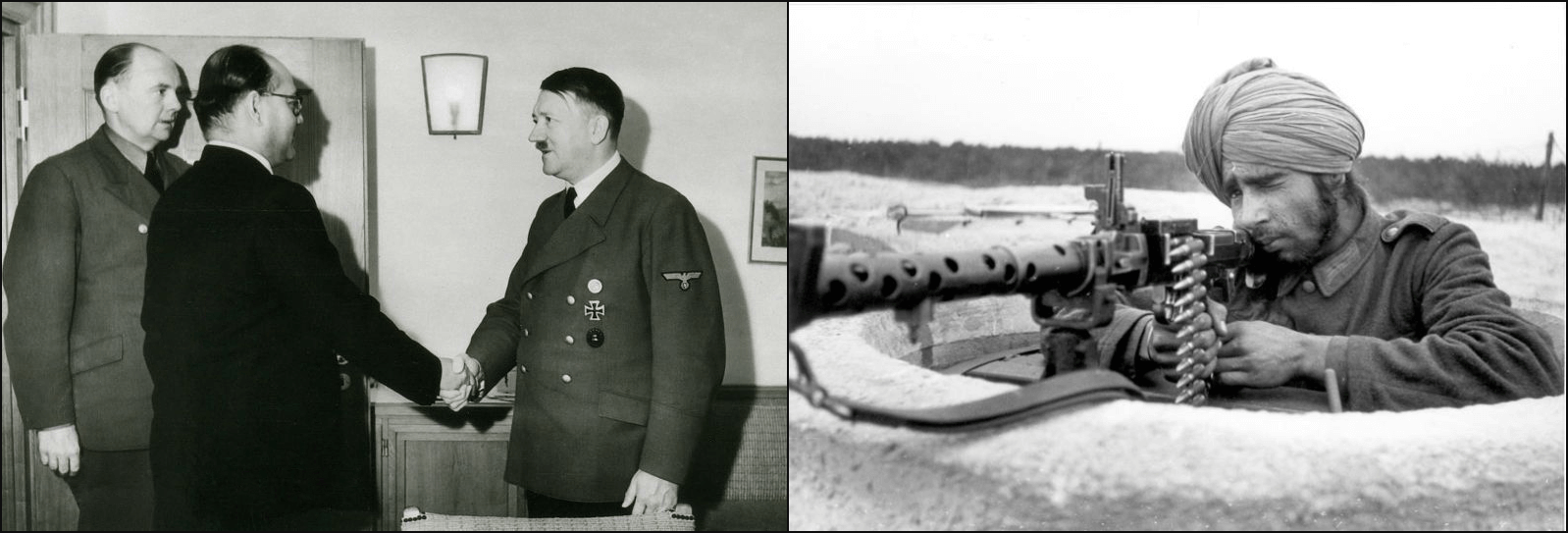
Left: Subhas Chandra Bose, middle, meeting Hitler in East Prussia, Germany May 27, 1942 (Wikimedia Commons). Right: German propaganda photo of Indian Legion soldier near Bordeaux, France, March 21, 1944 (Bundesarchiv, Bild 101I-263-1580-06/Wette via Wikimedia Commons). Image by Forward collage
This list is part of an ongoing investigative project the Forward first published in January 2021 documenting hundreds of monuments around the world to people involved in the Holocaust. We are continuing to update each country’s list; if you know of any not included here, or of statues that have been removed or streets renamed, please email [email protected], subject line: Nazi monument project.
Note: due to the overwhelming number of statues, plaques, institutions and street names for Subhas Chandra Bose in India, this section is only a partial listing.
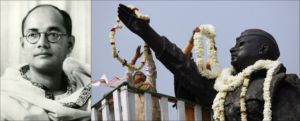
Kolkata — In 2019, then-chief of staff to Rep. Alexandria Ocasio-Cortez, D-N.Y., triggered headlines when he wore a T-shirt with the image of Nazi collaborator Subhas Chandra Bose (1897–1945). Bose, often called Netaji (“respected leader”), was an Indian nationalist who created and recruited soldiers for the Free India Legion aka the Indian Legion. Formed in 1941, the legion was originally part of the German army; in 1944 it was transferred to the Waffen-SS (the military wing of the Nazi Party responsible for, among other war crimes, the Holocaust) and became the Indian Volunteer Legion of the Waffen-SS. It fought against the Allies in France, where it was tasked with suppressing the French Resistance; the unit gained a dark reputation for crimes against civilians.
Bose aided Hitler’s cause even prior to recruiting soldiers for the Third Reich. In 1938, Jawaharlal Nehru, a hero of India’s freedom struggle who later became the country’s first prime minister, led the effort to allow Jewish refugees to escape persecution and come to India. Bose actively blocked Nehru’s attempt. (India ended up rescuing Jews and Poles – see the Forward, India Times, The Hindu and Atlas Obscura.)
Bose’s defenders use the same justification as whitewashers of other nationalist collaborators – they rebrand Bose and the Indian Legion as freedom fighters who fought against Britain, not lackeys who fought with Hitler. The fact remains, Bose recruited thousands of men who fought in the Waffen-SS against the Allies, suppressed anti-Nazi resistance and enabled Germany to continue its genocide of Jews and Roma.
The Kolkata metropolitan area is a hub of Bose glorification: in addition to the colossal statue at Maidan park, above right, Bose has an airport (with statue), road, metro station, stadium, memorial and research center (with bust), another museum, cancer research institute, ancestral house (with bust), college and university as well as statues/busts in the Alipore, Bablatala, Bagbazar, Baidyabati, Barasat (another statue and bust), Barrackpore, Baruipur, Belur, Bidhannagar (another statue and bust in Jai Hind Park), Budge Budge (and bust), Chengail, Chetla, Dakshineswar, Dasnagar, Dum Dum, Garia, Ghusuri, Haridevpur, Hridaypur, Ichapur (another statue, two busts and wall sculpture), Jagatdal (and bust), Jorasanko, Kamarhati, Kankurgachi, Konnagar, Liluah, Mali Panchghara, Nalpur, Narkeldanga, Paschim Barisha, Rajpur Sonarpur, Ram Bagan, Rania Mauza, Santoshpur, Santragachi, Satpukur, Serampore, Shyambazar (and relief sculpture), Sinthee, South Dum Dum (plus five busts: here, here, here, here and here), Subhasgram and Tangra neighborhoods/municipalities as well as at a naval military base named after him. See coverage in JTA, Newsweek and Jewish Journal with a quote from the Simon Wiesenthal Center.
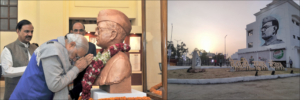
New Delhi and multiple other locations — India’s Prime Minister Narendra Modi, who champions the cult of Bose, with his bust in the capital of New Delhi, above left. The Delhi area also has a statue of Bose in the Parliament House, another statue, a park (with monument), university (with statue), a bust at Delhi University, museum, bust, metro station, neighborhood and sports complex.
In September 2022, Modi installed a Bose statue in the canopy of the India Gate, a colossal war memorial in the center of New Delhi, to commemorate the 75th anniversary of India’s independence as well as Bose’s 125th birthday. The unveiling was highly symbolic not only due to its prominent location but also because the canopy once housed a statue of George V, the colonial ruler of India.
Bose has an astounding number of statues, streets and institutions throughout India. A very partial list includes a museum and bust in Kurseong; a college (with bust), school (with bust), bridge and museum (with bust and statue) in Cuttack; a medical institute in Bhubaneswar and Bihta; a pharmaceutical institute in Tatla; a school (with bust) and statue in Agartala; a medical college and statue in Jabalpur; an institute, statue and memorial in Patna; a college and statue in Arambag, Murshidabad (statue here), Sambalpur and Udaipur; a rail station (with bas-relief) in Gomoh; a school in Doiwala; a college in Haldibari; statues/busts in Ailakundi P, Ajmer, Aligarh, Alipurduar (another statue), Amalner, Ambala (in Netaji Subhash Park) Amravati, Amritsar, Asansol (two statues and bust), Bainan, two in Bangalore, Bangaon, Bankura, Basirhat, Berhampore, Bhopal, Bijni, Bokajan, Bolpur, Budaun, Burdwan (another statue and three busts here, here and here), Burhanpur, Burikhali, Chakdaha, Chandrakona, Chennai (and bust), Chinchuria, Contai, Dakhin Narathali, Dalhousie, Daspur, Debra, Dhanyakuria, Dharwad, Dhatrigram, Dhule, Durgapur (and statue with separate map monument), Farakka, Gazole, Golakganj, Golapganj, Gunjapadugu, Gurugram, Guwahati (two more statues), two in Habra, Haldia, Haridwar, Hatgram, Hisar, Indore, Islampur, Jaigaon, Jaipur, Jalpaiguri, Jamnagar, Jamshedpur (and a university), Jasthipalli, Jiaganj, Kakraban, Kalna, Kalyayni, Karon, Katwa, Khammam, Kharagpur, Kolaghat, Kothapalle (Karimnagar district), Kotulpur, Krishnanagar, Lakhana Bandha, Lakhipur, Lapuria, Lucknow, Madurai, Magurali, Mahishasthali, Mal Bazar, Malda, Manwath, Marsur, Moiran, Mucherla, Mukkapadu, two in Mumbai, Nagaon, Nagpur (and a bust), Nalhati, Palampur, Parulia, Pingla, Plassey, Port Blair (and stadium), Prayagraj, Puri (and museum), Rajkot, Rajmahal, Ramajipet, Ramjibanpur, two in Ranaghat, Rewa, Sadpur, Sainthia, Salboni, Santoshpur Pila, Secunderabad, Shillong (another at the State Central Library), Siddipet, Silchar, Siliguri (bust and more statues here, here, here and here), Singur, Suri, Taherpur, Tarakeswar, Thiruvananthapuram, Tinsukia, Vadodara, Vemulawada and Visakhapatnam; a temple in Varasani; a stadium in Raipur (above right); and an island in the Andamans.
Below left, Bose meets with Hitler in East Prussia, 1942. That year, he also met with Heinrich Himmler, head of the SS and one of the principal architects of the Holocaust. Below right, Indian Legion fighter mans a post in Bordeaux, 1944.
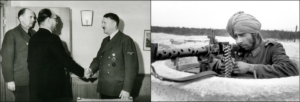
Note: the Netaji Subhas Chandra Bose All India Institute of Medical Sciences in Bhubaneswar has been renamed All India Institute of Medical Sciences, Bhubaneswar. The following were added to this entry in January 2023: India Gate; Dhule; Golakganj; Hatgram; Jaigaon; Lakhipur; Malda; Sadpur; the second Alipurduar and the second Nagpur monuments; the college and statue in Sambalpur; and the universities in Jamshedpur and Tatla.
The Forward is free to read, but it isn’t free to produce

I hope you appreciated this article. Before you go, I’d like to ask you to please support the Forward.
Now more than ever, American Jews need independent news they can trust, with reporting driven by truth, not ideology. We serve you, not any ideological agenda.
At a time when other newsrooms are closing or cutting back, the Forward has removed its paywall and invested additional resources to report on the ground from Israel and around the U.S. on the impact of the war, rising antisemitism and polarized discourse.
This is a great time to support independent Jewish journalism you rely on. Make a gift today!
— Rachel Fishman Feddersen, Publisher and CEO
Support our mission to tell the Jewish story fully and fairly.
Most Popular
- 1

Fast Forward Ye debuts ‘Heil Hitler’ music video that includes a sample of a Hitler speech
- 2

Opinion It looks like Israel totally underestimated Trump
- 3

Culture Cardinals are Catholic, not Jewish — so why do they all wear yarmulkes?
- 4

Fast Forward Student suspended for ‘F— the Jews’ video defends himself on antisemitic podcast
In Case You Missed It
-

Culture Should Diaspora Jews be buried in Israel? A rabbi responds
-

Fast Forward In first Sunday address, Pope Leo XIV calls for ceasefire in Gaza, release of hostages
-

Fast Forward Huckabee denies rift between Netanyahu and Trump as US actions in Middle East appear to leave out Israel
-
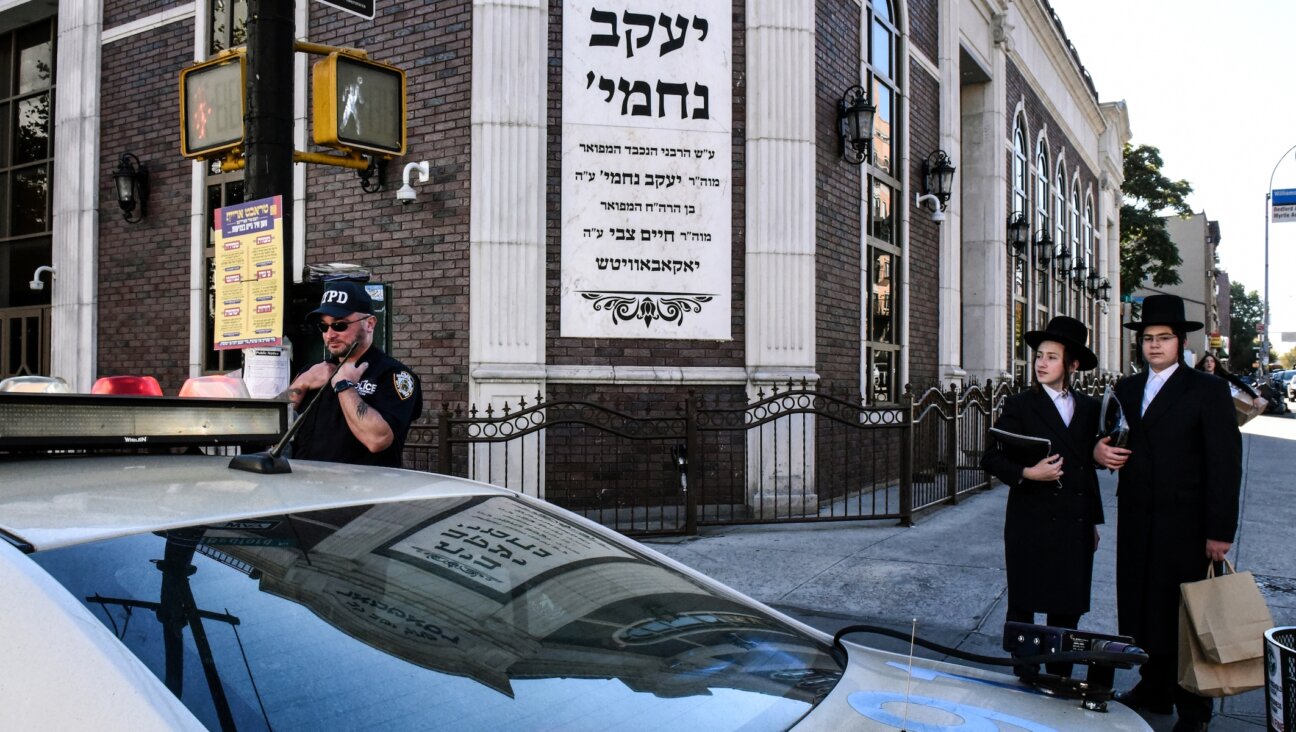
Fast Forward Federal security grants to synagogues are resuming after two-month Trump freeze
-
Shop the Forward Store
100% of profits support our journalism
Republish This Story
Please read before republishing
We’re happy to make this story available to republish for free, unless it originated with JTA, Haaretz or another publication (as indicated on the article) and as long as you follow our guidelines.
You must comply with the following:
- Credit the Forward
- Retain our pixel
- Preserve our canonical link in Google search
- Add a noindex tag in Google search
See our full guidelines for more information, and this guide for detail about canonical URLs.
To republish, copy the HTML by clicking on the yellow button to the right; it includes our tracking pixel, all paragraph styles and hyperlinks, the author byline and credit to the Forward. It does not include images; to avoid copyright violations, you must add them manually, following our guidelines. Please email us at [email protected], subject line “republish,” with any questions or to let us know what stories you’re picking up.









